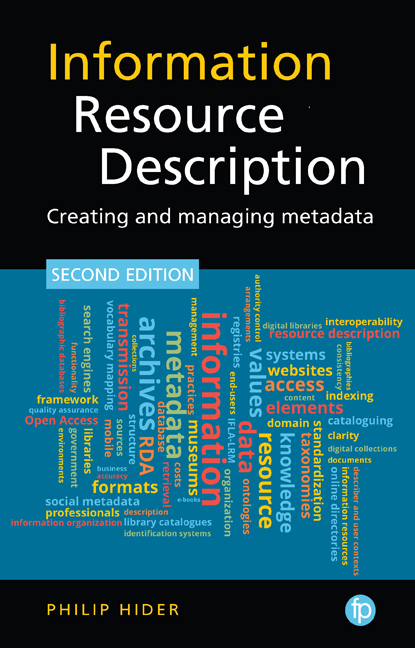Book contents
- Frontmatter
- Dedication
- Contents
- List of figures and tables
- Preface to the First Edition
- Preface to the Second Edition
- List of abbreviations
- 1 Definitions and scope
- 2 Information resource attributes
- 3 Tools and systems
- 4 Metadata sources
- 5 Metadata quality
- 6 Sharing metadata
- 7 Metadata standards
- 8 Vocabularies
- 9 The future of metadata
- Further reading
- List of metadata standards
- Index
2 - Information resource attributes
Published online by Cambridge University Press: 24 September 2019
- Frontmatter
- Dedication
- Contents
- List of figures and tables
- Preface to the First Edition
- Preface to the Second Edition
- List of abbreviations
- 1 Definitions and scope
- 2 Information resource attributes
- 3 Tools and systems
- 4 Metadata sources
- 5 Metadata quality
- 6 Sharing metadata
- 7 Metadata standards
- 8 Vocabularies
- 9 The future of metadata
- Further reading
- List of metadata standards
- Index
Summary
Introduction
In the previous chapter we talked of metadata elements, the building blocks of information resource description. Each element describes an aspect, or attribute, of the information resource. Its title, author, subject, size, publication date and so on – all are attributes that could be described if applicable to a particular resource. As was mentioned, there are countless ways in which one could look at, and therefore describe, an information resource. Clearly, some attributes are more relevant in the provision of information access than others. This chapter will discuss which attributes are likely to be more important, and why.
In some more technical discussions, a resource's attributes are distin - guished from its relationships to other entities. In such a model, a book's size might be considered an attribute, whereas its author might be considered another entity with an ‘authorial’ relationship to the book. The distinction will not be pursued here, however, as ultimately it is one of expression: any attribute could be expressed as a relationship between two entities (e.g. the concept ‘folio’ might have a ‘size’ relationship to a book), and any relationship could be expressed as an attribute (e.g. authorship). Nevertheless, expressing and presenting metadata in the form of relationships can be a very effective mode of description, as we shall later observe.
Describer and user contexts
Information resource description is inevitably biased: it is influenced by the motives, situation, limitations and world-view of its creator. This is true regardless of how much the creator wishes to assist prospective users. Even information professionals, who may profess a ‘neutral’ position, will invariably have a particular take on how best to serve users’ needs. The field of information organization has developed various policies and standards that are generally regarded as ‘good practice’, but few would seriously contend that any of them were perfect solutions (even in a particular context). Nevertheless, metadata creators should all start with the same fundamental question: what metadata will most help users to obtain the information they are looking for?
- Type
- Chapter
- Information
- Information Resource DescriptionCreating and Managing Metadata, pp. 23 - 42Publisher: FacetPrint publication year: 2018



